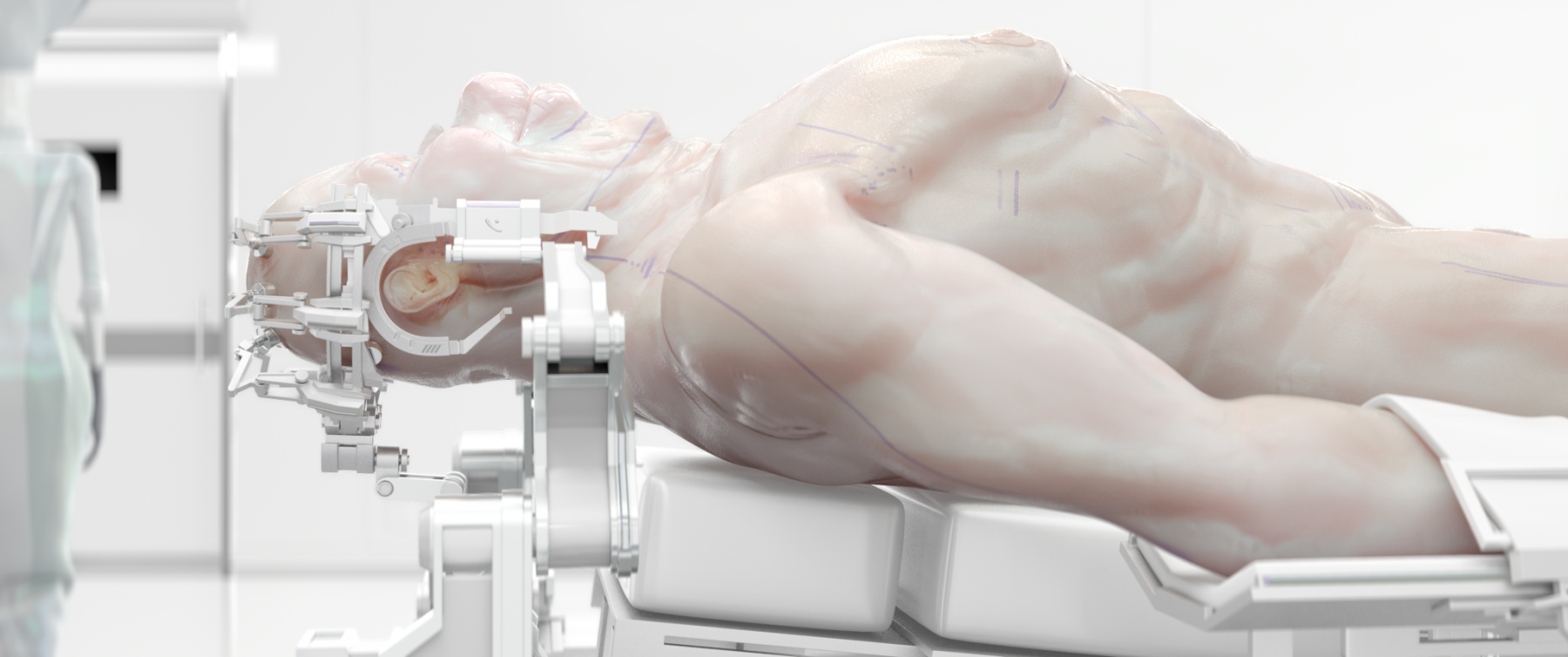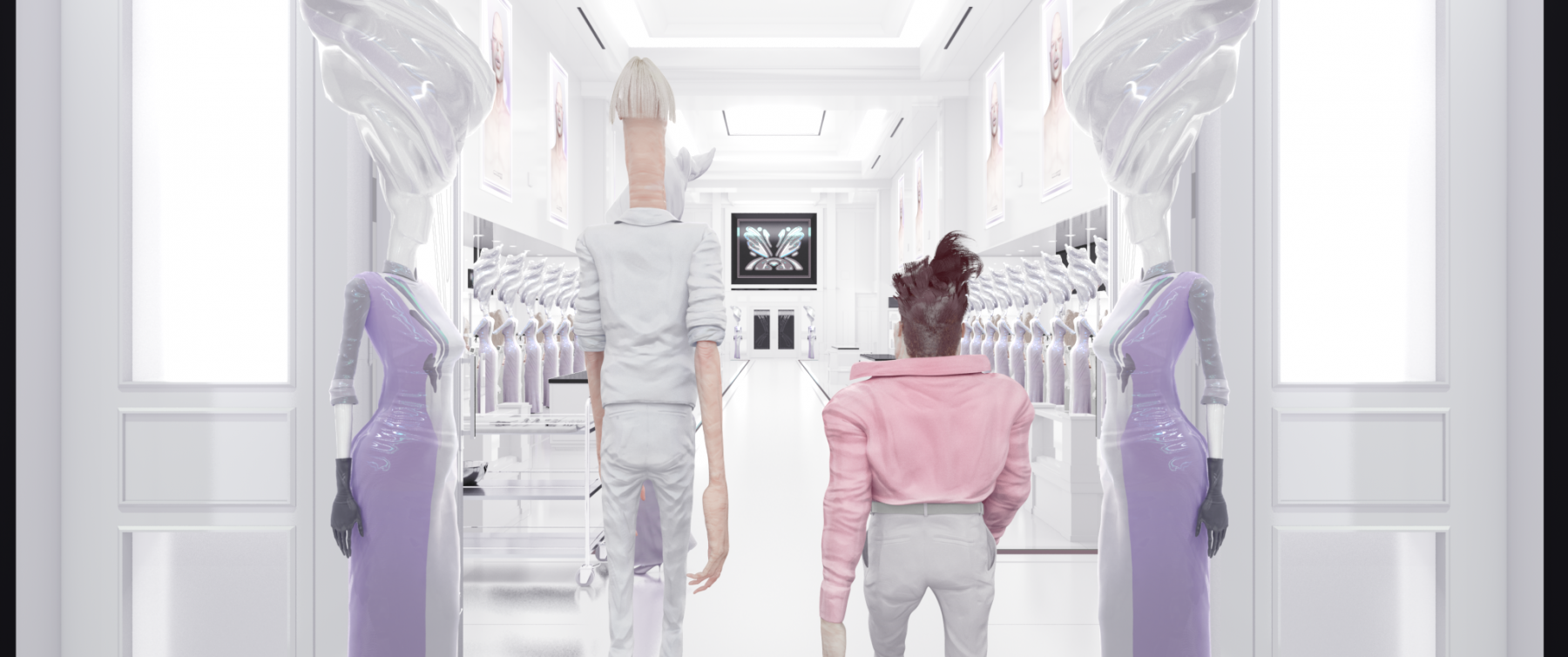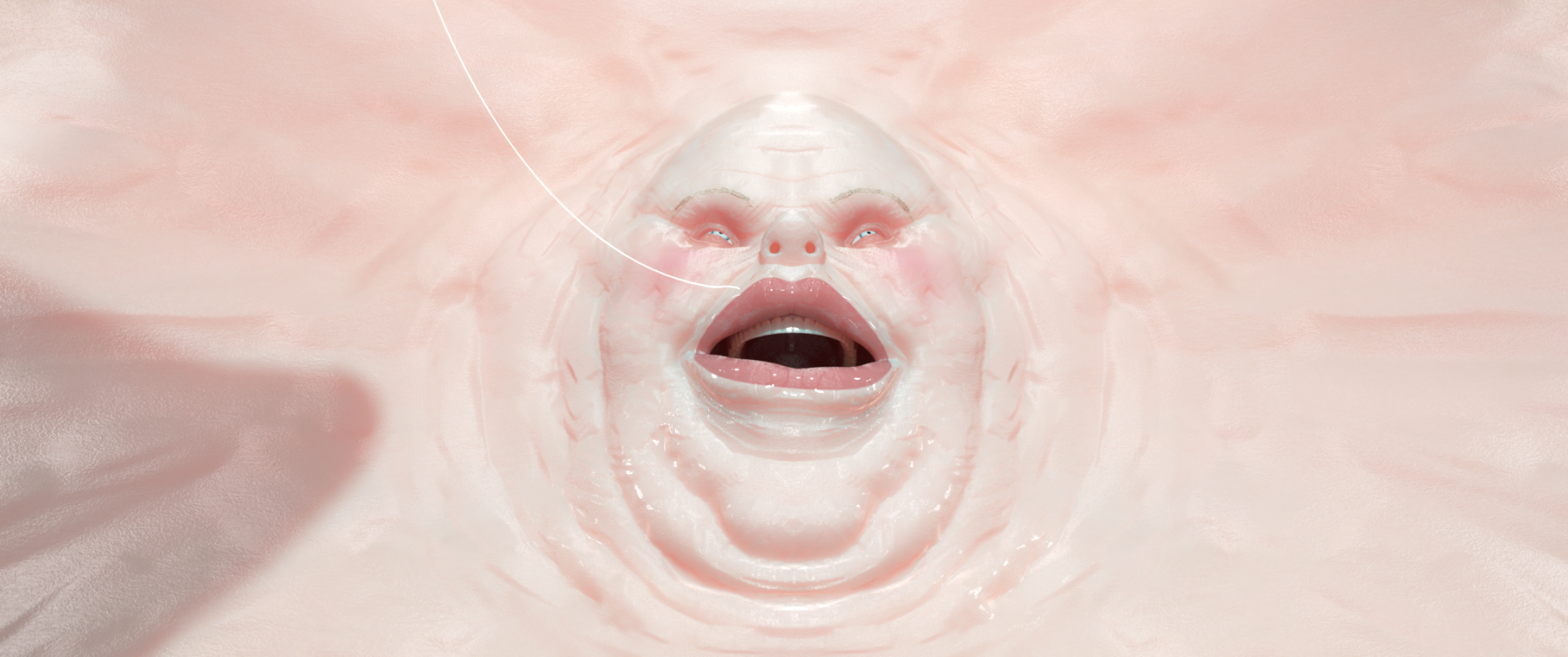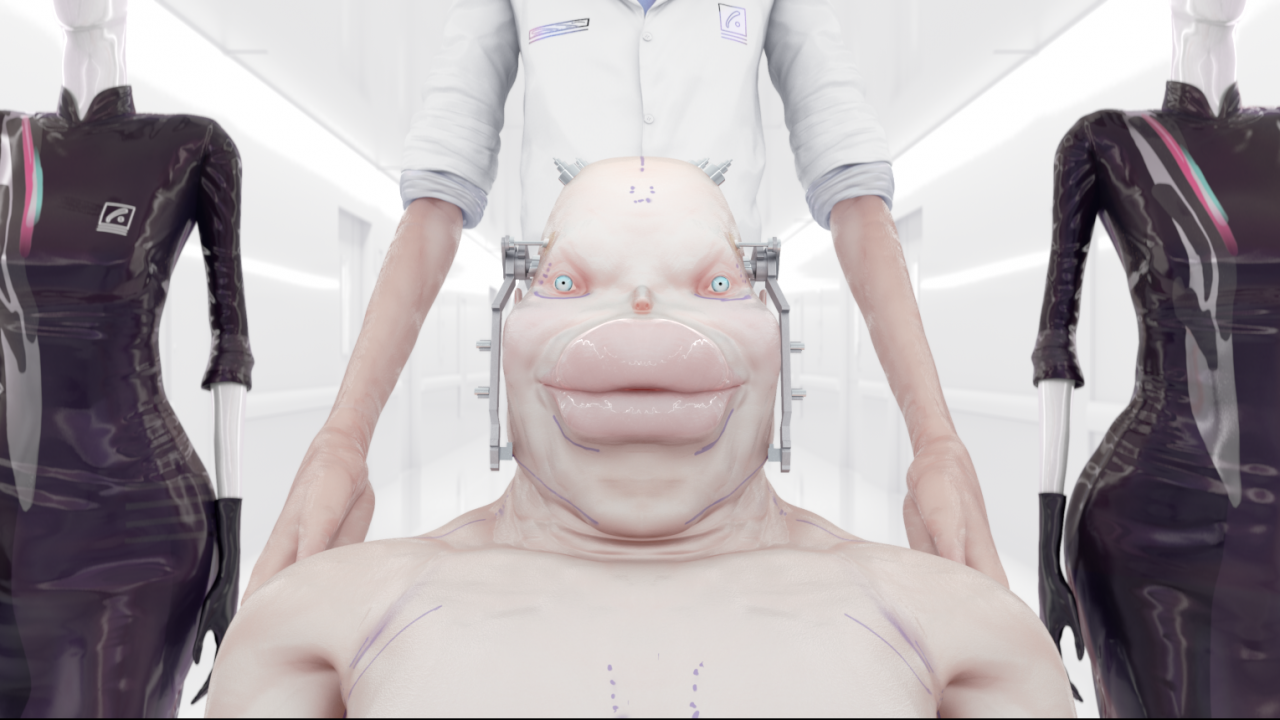
Director’s Notes : The Origins of Caterpillarplasty
Director’s Notes : The Origins of Caterpillarplasty
I had just finished working on Bless You, a short film about a man who sneezes and undergoes a complete death and rebirth. The film played at the Ottawa International Animation Festival, toured in the Animation Show of Shows and was a Staff Pick on Vimeo. I was surprised at the reception and was coming off a creative high, eager to dive into something new.
Prior to making that film, I had mostly worked with 2D animation. But with Bless You, I went a bit further, using things like projection painting on 3D objects and camera movements. I wanted to create a sort of grotesque animated realism that fused film cinematics and hand-drawn cartooniness.
I loved the visceral style and quirkiness of cartoons like Ren & Stimpy—with those high-detail cut-ins on crusty lips and hairy armpits—and the dark tones in certain sci-fi films and music videos. I wanted to try to bring together these aesthetics in a weird fusion of styles.
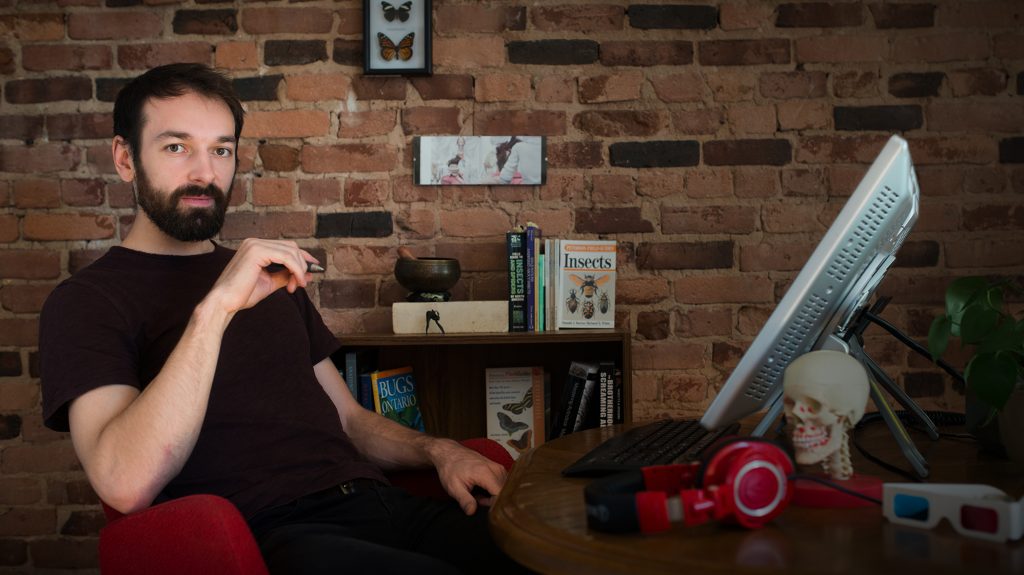
I quickly learned that trying to re-create materials like human skin, hair, cloth, metallic and wet surfaces by hand was way too time-consuming, so I started experimenting with other mediums. I was pretty enamored by what I saw other artists doing with tools like ZBrush and the numerous 3D renderers, and the potential to mimic real-world lights and textures in photo-realistic ways. I decided that my next film would be done that way.
John K, Looney Tunes and Plastic Surgery
I did a lot of figure drawing while I was in art school, studying human-anatomy books and drawing people on street corners. My passion lies in working with the human face, paying close attention to the emotions conveyed and distorting them to be more expressive than in the real world.
I’m a big fan of the work of John Kricfalusi. He has an interesting way of breaking down the process and is one of the few artists who can really make me laugh with his drawings. I learned a lot from studying his work. I wanted to make a film that would allow me to push my understanding of caricature to the next level.
The plastic surgery idea for Caterpillarplasty first came about when I was re-watching an old Looney Tunes cartoon. One of the gags in “Rabbit of Seville” involves Bugs Bunny giving Elmer Fudd a makeover, applying lotion to his face and massaging his skin as they bounce along to the music. I thought it would be really fun to do something like that in my own style, using 3D animation.
https://www.facebook.com/nfb.ca/videos/270290503611071
As I went along, the idea of a makeover eventually turned into a plastic-surgery operation. It seemed liked a perfect context in which to set the story, since it would give me the opportunity to play with all kinds of designs for the human face. I started learning about the popular figures in the worlds of body-modification and plastic surgery, such as celebrity surgeons like Robert Rey and numerous personalities, including Justin Jedlica, Rodrigo Alves and the Bogdanoff twins, to name a few. I became fascinated by these individuals, their stories and this subculture that I previously knew nothing about.
After Bless You, I worked with Canadian animation director Sheldon Cohen on his NFB film My Heart Attack. The film is a personal story about his experience going through open-heart surgery. I shared an office with him through the duration of the film’s production and we saw each other nearly every day for about a year.
We became quite close. I became absorbed in visual research for his film, looking at lots of images of hospitals and operating rooms as reference material to create background paintings and designs. Many of these images subconsciously fed into my creative process in developing Caterpillarplasty.
My Heart Attack, Sheldon Cohen, provided by the National Film Board of Canada
Animation Expressing the Ineffable
Sheldon had kept a journal of notes and drawings about his experience of going through surgery, in his attempt to convey the sensations he felt—the aches, pains, and vivid dreams—when he was in the hospital.
Some of these were pretty nightmarish. He wanted to use animation to bring these impressions to life and have them make sense visually in the film. He shared this journal with me with the intention of having it feed into the artwork in the film. It was a pretty intimate experience; some of the notes in those journals were pretty raw. It was humbling to realize how difficult it would be to put them down into something concrete. However, to be given the task of coming up with images to convey dream-like states of mind was something that was right up my alley.
Touching on themes of spirituality and close encounter with death, I found myself becoming curious about what it would be like to go through such an experience. What would it feel like to have one’s heart stop for several minutes?
I found myself looking into things like near-death experience, altered states of consciousness attained through meditation, drugs and other spiritual practices. I was intrigued by the association made between intense hallucinogens and near-death experience.
Death and Rebirth
I remembered listening to a podcast about the life-cycle of butterflies that described the chemical changes occurring inside the chrysalis. If you were to look inside the chrysalis mid-way through the process of metamorphosis, you wouldn’t see anything resembling a caterpillar or a butterfly, but rather a featureless sac of goo consisting of nutrients and stem cells, not unlike the yolk inside a chicken egg.
The butterfly grows from this almost like a newborn fetus. There was something about this that really intrigued me—the idea that a single organism could break down completely and be put back together into something entirely new, in a sense, undergoing a complete death and rebirth.
Canadian Heritage Commercials and David Lynch
I remembered a Canadian Heritage commercial that I’d seen on TV when I was a kid, in which this woman would have repeated seizures. Every time they arose, she would experience the smell of burned toast. She was taken to the hospital to undergo an operation, and they discovered that they could induce the smell of burned toast by stimulating certain regions of her brain. The doctor who made the discovery was Wilder Penfield.
As I was developing the film, one of the first images that came to mind was the image of a tongue going into an ear, pushing deep inside the person’s head, all the way into the brain. Along the way, it would activate all kinds of phantom sensations and false memories. As the film came together, I figured that maybe this scene could be part of some sort of medical procedure in this bizarre animated universe.
I imagined this giant caterpillar creature, an insect-human hybrid, genetically engineered in the lab to facilitate metamorphosis in humans. Inside the glands of its tongue, it produces the key chemical component that acts as a catalyst to trigger the transformation. The Guild Navigator from David Lynch’s Dune was one of my inspirations.
When thinking of a title for the film, I was looking at the names of all these different kinds of plastic-surgery procedures: rhinoplasty, abdominoplasty, brachioplasty, etc. I put two and two together. Caterpillarplasty felt right.
Butterflies and Ayahuasca
I had heard a great deal about this thing called ayahuasca, a tea made from vines and leaves found in Central/South America and produced by the tribes in the Amazonian regions. You drink it in a ceremonial setting and experience powerful, dream-like states of consciousness. The name translates as “vine of the soul,” and the tribes who derived it say that it gives people the power to speak to spirits and ancestors.
In 2015, just before I had started production on Caterpillarplasty, I had travelled to Central America and had my own experience with this stuff. You drink this brown sludge in a dark cabin with a bunch of fellow travellers, sit back on a mat, and within about an hour or so, find yourself immersed in a crazy light-show behind closed eyes. It goes on for hours.
Your mind is racing with thousands of strobing images—high-contrast neon geometric three-dimensional objects, juxtaposed with impressions from your life, all scrambled up and recombined in a way that almost feels like you’re looking at somebody else’s life.
You go spiralling in thought loops on issues of identity, memory, personal narrative, where associations between things become highly metaphorical, even poetic. It makes you laugh out loud, cry, be disturbed, aroused, and there’s a feeling of seeing patterns in everything. One definitely comes out of it with a lot of questions and a great deal of appreciation to be back in one’s own body.
These experiences are quite profound, and it’s humbling to realize that there’s something universally human in all this. Perhaps one gets a glimpse into what mystics have encountered throughout the ages with insights about the true nature of the universe.
I spent the following two weeks travelling, driving through the countryside, going for hikes up waterfalls and walks through the jungle. I remember feeling so inspired. I just wanted to return home and make art. I passed through Costa Rica and visited a number of insect sanctuaries. It felt strangely fitting to find myself in the land of the butterflies.
Slippery Smooth Aesthetic
The look and feel of Caterpillarplasty really came together in the lighting and rendering. I had seen this image of a Lapalux album cover, of a cocktail glass in front of an infinite mirror. The spotlights were reflected many times on all the surfaces and it created this effect of making things look shiny, expensive, almost jewel-like. I wanted to find a way to replicate that effect in the film.
I worked with a lot of glossy materials. I even painted reflective layers over certain areas on the skin of the characters, like the lips, to have them feel wet and shiny. I looked at photos in fashion magazines and beauty advertising, taking note of the lighting styles and trying to figure out the visual language of these photographic styles.
I designed an iridescent material that I applied to some of the metals and staff uniforms. The idea was to replicate the rainbow colour effect seen on certain beetle shells and butterfly wings, where the reflection colour changes based on viewing angle.
Post-Caterpillarplasty
Doing a full 3D production at this scale was challenging and rewarding. Despite the time-consuming nature of working in a photo-realistic style, the results are totally worthwhile. I really enjoyed designing characters that look and feel real, yet have qualities of something unreal, making things feel slightly off and getting that uncanny look that tends to evoke uneasy feelings.
I’d love to get into facial and body-motion capture, being able to work with actors on set and having the movements from real people mapped onto the characters. I worked a lot with cloth simulation to create the squishy skin. The lead, Beau, has big fleshy lips, so I think I would really get a kick out of seeing a face like his come alive when driven by real human performance.
I still find myself thinking a lot about film ideas that communicate inner experience: dream, fantasy, hallucination. Some of the things I have seen behind closed eyes in my own lifetime have been very beautiful, and I still feel I have only touched the tip of the iceberg in putting these images on film.
